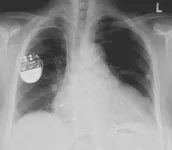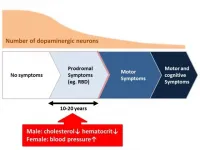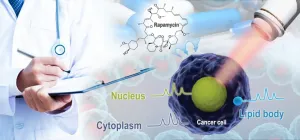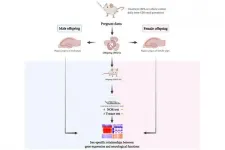How to find mutated sperm? Just go FISH
A new test quickly and easily identifies when sperm are carrying chromosomal mutations, and could be applied for men hoping to have children
2021-01-19
(Press-News.org) Chemotherapy and radiation treatments are known to cause harsh side effects that patients can see or feel throughout their bodies. Yet there are additional, unseen and often undiscussed consequences of these important therapies: the impacts on their future pregnancies and hopes for healthy children.
Extensive evidence shows that chemotherapy and radiation treatments are genotoxic, meaning they can mutate the DNA and damage chromosomes in patients' cancerous and noncancerous cells alike. When this occurs in a germline cell - which are egg cells in women and sperm in men - it can lead to serious fetal and birth defects in a resulting pregnancy. For the few chemotherapies that have been studied, the risk of mutated sperm diminishes over time, as the treatment agents leave the body and men produce new sperm that were never exposed to the genotoxic agents. But for most chemotherapeutic drugs, there is still no information on their impact on DNA mutations and chromosomal damage to human sperm.
Exacerbating the problem, there are currently no efficient and affordable tests that can be used to track men's germ cell health by identifying when the sperm are carrying treatment-related chromosomal mutations such as aneuploidy (abnormal number of chromosomes) or chromosome breaks, rearrangements, or deletions. But evidence from a new study led by Andrew Wyrobek at the Lawrence Livermore National Laboratory, and now at the Lawrence Berkeley National Laboratory (Berkeley Lab), suggests that this may soon change.
In a paper published in the journal PLOS ONE, an international team reported success adapting an established cellular DNA analysis technique called fluorescence in situ hybridization (FISH) to probe sperm DNA for a wide variety of chromosomal defects simultaneously. This version of the FISH technique, known as the AM8 sperm FISH protocol, is the result of decades of work done by the research team of lead author Andrew Wyrobek. A medical biophysicist at Berkeley Lab, Wyrobek studies the effects of ionizing radiation and human-made chemicals on breast cancer, brain function, and male reproductive health.
"This work is the first demonstration that our sperm assay can simultaneously measure aneuploidy and other chromosomal aberrations in sperm from men who have undergone genotoxic treatments," said Wyrobek. "When sperm with these chromosomal abnormalities fertilize an egg, the resulting fetus and live-born child may have severe health issues. For example, fetuses with trisomy 18 - an extra copy of chromosome 18 or a fetus with an unbalanced chromosomal rearrangement - typically die in utero or within a year of birth."
And, most importantly, according to Wyrobek, the assay can detect balanced chromosomal abnormalities, which are rearrangement with no loss or gain of genetic material. Balanced rearrangements are compatible with live birth and heritable to future pregnancies, and affected children are likely to experience reduced fertility when they want to have children of their own.
The team - which included scientists from Lawrence Livermore National Laboratory, Stanford University, MD Anderson Cancer Center, and the National Autonomous University of Mexico - evaluated the AM8 FISH approach on sperm from nine Hodgkin lymphoma patients, who provided samples before, during, and after a multi-drug treatment regimen and radiation therapy.
Results from the FISH protocol tests indicated that sperm produced during the Hodgkin lymphoma treatment had 10 times more chromosomal defects compared with sperm produced prior to treatment. But by month six post-treatment, the patients' sperm had returned to pre-treatment quality.
"We are excited by these results because they are a first step toward applying this method to any human situation - such as aging, illness, drugs, or exposure to environmental toxicants - to determine genetic risks to male germ cells and to examine the persistence of chromosomally damaged sperm," said Wyrobek. "We believe this approach has a wide range of applications in healthcare and family planning, as it can be used to identify environmental exposures that increase the risk for producing chromosomally abnormal sperm that can affect the health of future pregnancies and children for generations to come."
However, according to Wryobek, the sperm FISH method is still in an early research phase and it will require additional validation and commercial development before it becomes available in doctor's offices.
INFORMATION:
This work was supported by the National Institute of Environmental Health Science and the authors' respective institutions.
Founded in 1931 on the belief that the biggest scientific challenges are best addressed by teams, Lawrence Berkeley National Laboratory and its scientists have been recognized with 14 Nobel Prizes. Today, Berkeley Lab researchers develop sustainable energy and environmental solutions, create useful new materials, advance the frontiers of computing, and probe the mysteries of life, matter, and the universe. Scientists from around the world rely on the Lab's facilities for their own discovery science. Berkeley Lab is a multiprogram national laboratory, managed by the University of California for the U.S. Department of Energy's Office of Science.
DOE's Office of Science is the single largest supporter of basic research in the physical sciences in the United States, and is working to address some of the most pressing challenges of our time. For more information, please visit energy.gov/science.
[Attachments] See images for this press release:
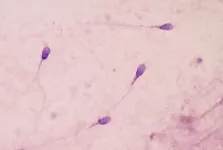
ELSE PRESS RELEASES FROM THIS DATE:
2021-01-19
A new type of ultra-efficient, nano-thin material could advance self-powered electronics, wearable technologies and even deliver pacemakers powered by heart beats.
The flexible and printable piezoelectric material, which can convert mechanical pressure into electrical energy, has been developed by an Australian research team led by RMIT University.
It is 100,000 times thinner than a human hair and 800% more efficient than other piezoelectrics based on similar non-toxic materials.
Importantly, researchers say it can be easily fabricated through a cost-effective and commercially scalable method, using ...
2021-01-19
A research team led by Nagoya University in Japan has found that blood pressure, the hematocrit (the percentage of red blood cells in blood), and serum cholesterol levels change in patients with Parkinson's disease long before the onset of motor symptoms. This finding, which was recently published online in Scientific Reports, may pave the way for early diagnosis and treatment of the disease.
Parkinson's disease, the second most common disease affecting the nervous system after Alzheimer's disease, is caused by a deficiency in a neurotransmitter called dopamine. It is known that more than half of all dopaminergic neurons are already lost in patients with Parkinson's disease in the stage wherein they ...
2021-01-19
India has an energy problem. It currently relies heavily on coal and consumer demand is expected to double by 2040, making its green energy targets look out of reach. Part of the solution could come from harvesting energy from footsteps, say Hari Anand and Binod Kumar Singh from the University of Petroleum and Energy Studies in Dehradun, India. Their new study, published in the De Gruyter journal Energy Harvesting and Systems, shows that Indian attitudes towards power generated through piezoelectric tiles are overwhelmingly positive.
Cities like Delhi and Mumbai are famously crowded, especially at railway stations, temples and big commercial buildings. This led researchers to wonder whether piezoelectric tiles, which produce ...
2021-01-19
Researchers have used the world's smallest, smartphone-sized DNA sequencing device to monitor hundreds of different bacteria in a river ecosystem.
Writing in the journal eLife, the interdisciplinary team from the University of Cambridge, UK, provide practical and analytical guidelines for using the device, called the MinION (from Oxford Nanopore Technologies), to monitor freshwater health. Their guidelines promise a significantly more cost-effective and simple approach to this work outside the lab, compared to existing methods.
Rowers and swimmers in Cambridge are regularly affected by waterborne infections such as Weil's disease, sometimes leading to public closures of the city's iconic waterways. Monitoring the microbial species in freshwater ...
2021-01-19
Whether consciously or unconsciously, automotive firms time their product recalls to minimize stock price penalties, resulting in unnecessary delays and clusters of subsequent recalls by other companies, according to new research from the University of Notre Dame.
An initial recall by one firm prompts clusters of additional recalls in close proximity by competitor firms, according to "Hiding in the Herd: The Product Recall Clustering Phenomenon," forthcoming in Manufacturing and Service Operations Management from Kaitlin Wowak, assistant professor of IT, analytics, and operations at Notre Dame's Mendoza College of Business.
According to the study, "Automobile recalls seem to be announced after inexplicable delays. Toyota's unintended acceleration recall and General ...
2021-01-19
Nearly 78 per cent of children with autism have at least one mental health condition and nearly half have two mental health conditions or more, according to a new U.S. study from the University of British Columbia's department of psychology and the AJ Drexel Autism Institute at Drexel University (Pennsylvania).
The study also found mental health conditions present in 44.8 per cent of pre-school age children with autism. The scope of the issue among that age group had not previously been established using a large, population-based sample.
By contrast, the study found that only 14.1 per cent of youth without autism (ages 3-17) had mental health conditions.
It is the first research since 2008 to examine the prevalence of mental health conditions among children with autism at a population ...
2021-01-19
Malta, a sovereign microstate in the middle of the Mediterranean Sea, has no shortage of sunny beaches, honey-bricked villages and rugged countryside. Beyond its Mediterranean charm, Malta is home to a geographically and culturally isolated population whose unique genetic makeup, makes this island nation a goldmine for genetics research.
Four years ago, the University of Malta set up a national ALS Registry and Biobank to identify patients with amyotrophic lateral sclerosis (ALS) and collect data on their residence, occupation, lifestyle and environmental exposures. Blood samples ...
2021-01-19
With the global student community taking online courses as a result of the anti-Covid-19 measures, a study led by the University of Geneva (UNIGE) reveals that online courses deepen inequalities between gifted and less gifted students by 5%. The results of the study, which was based on data collected in 2016-2017 prior to the anti-Covid lockdown initiatives, are published in the Journal of the European Economic Association. They indicate that this learning gap between different student profiles is mainly due to their behaviour and motivation. The study gives higher education establishments worldwide practical ways to deal with lockdown or the chronic lack of space in lecture theatres, including via co-educational ...
2021-01-19
Cancer cells are smart when it comes to anti-cancer drugs, evolving and becoming resistant to even the strongest chemotherapies over time. To combat this evasive behavior, researchers have developed a method named D2O-probed CANcer Susceptibility Test Ramanometry (D2O-CANST-R) to see, at single-cell/organelle level, how pharmaceuticals induce cancer cell death and how cancer cells adapt.
The research, conducted by the Qingdao Institute of Bioenergy and Bioprocess Technology (QIBEBT) of the Chinese Academy of Sciences (CAS), was published on Jan. 12 in Analytical Chemistry, ...
2021-01-19
A new study by researchers from Chulalongkorn University, Tohoku University, and The George Washington University is the first to identify autism candidate genes that may be responsible for the sex-specific effects of bisphenol A (BPA) on the brain. It suggests BPA may serve as an environmental factor that contributes to the prevalence of male bias in autism spectrum disorder (ASD).
The research was published in the journal Scientific Reports.
BPA is widely used in many products in our daily life and abundant in micro/nanoplastics found in the environment, ...
LAST 30 PRESS RELEASES:
[Press-News.org] How to find mutated sperm? Just go FISH
A new test quickly and easily identifies when sperm are carrying chromosomal mutations, and could be applied for men hoping to have children

